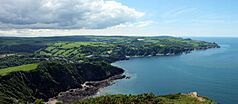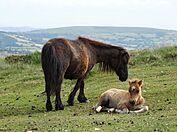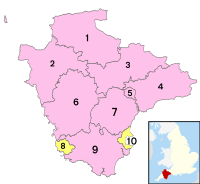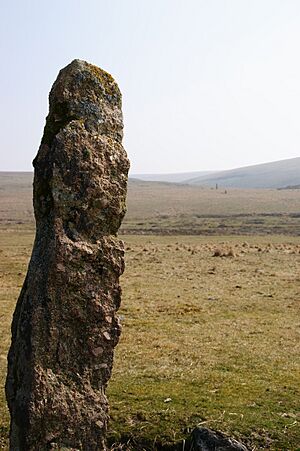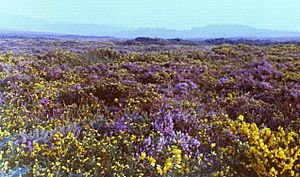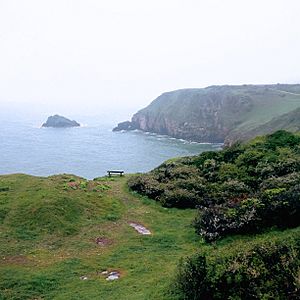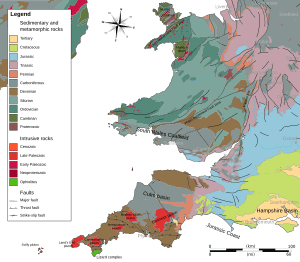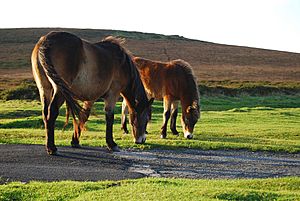Devon facts for kids
Quick facts for kids
Devon
|
|||||||||||||||||||||||||||||||||||||||||||||||||||||||||||
|---|---|---|---|---|---|---|---|---|---|---|---|---|---|---|---|---|---|---|---|---|---|---|---|---|---|---|---|---|---|---|---|---|---|---|---|---|---|---|---|---|---|---|---|---|---|---|---|---|---|---|---|---|---|---|---|---|---|---|---|
|
Clockwise from top: the Devon coast at Combe Martin; ponies on Dartmoor; and Smeaton's Tower, Plymouth Hoe
|
|||||||||||||||||||||||||||||||||||||||||||||||||||||||||||
|
|||||||||||||||||||||||||||||||||||||||||||||||||||||||||||
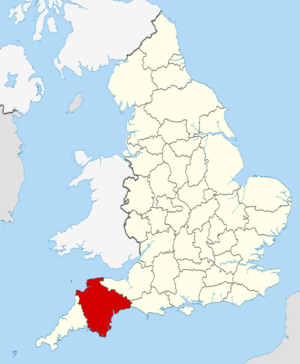
Devon within England
|
|||||||||||||||||||||||||||||||||||||||||||||||||||||||||||
| Sovereign state | United Kingdom | ||||||||||||||||||||||||||||||||||||||||||||||||||||||||||
| Constituent country | England | ||||||||||||||||||||||||||||||||||||||||||||||||||||||||||
| Region | South West | ||||||||||||||||||||||||||||||||||||||||||||||||||||||||||
| Established | Ancient | ||||||||||||||||||||||||||||||||||||||||||||||||||||||||||
| Time zone | UTC±00:00 (Greenwich Mean Time) | ||||||||||||||||||||||||||||||||||||||||||||||||||||||||||
| • Summer (DST) | UTC+01:00 (British Summer Time) | ||||||||||||||||||||||||||||||||||||||||||||||||||||||||||
| Members of Parliament | List of MPs | ||||||||||||||||||||||||||||||||||||||||||||||||||||||||||
| Police | Devon and Cornwall Police | ||||||||||||||||||||||||||||||||||||||||||||||||||||||||||
|
|||||||||||||||||||||||||||||||||||||||||||||||||||||||||||
Devon (/ˈdɛvən/ DEV--ən), also known as Devonshire, is a county in South West England. It has a long coastline along the Bristol Channel to the north and the English Channel to the south. To its east are Somerset and Dorset, and to its west is Cornwall.
The largest city in Devon is Plymouth. The county town, which is like its main city for local government, is Exeter. Devon covers about 2,590 sq mi (6,700 km2) and has a population of over 1.1 million people. After Plymouth, the biggest places are Exeter and the coastal towns of Torquay and Paignton. These are mostly on the south coast, where most people live. In the north, Barnstaple is the largest town, and Tiverton is the biggest in the middle of the county.
Devon has many different types of landscapes. It includes Dartmoor and part of Exmoor, which are wild, open moorlands. Many of Devon's rivers, like the Taw, Dart, and Exe, start in these areas. The longest river, the Tamar, forms most of the border with Cornwall.
The southeast coast is part of the famous Jurassic Coast World Heritage Site. This area has tall cliffs that show rocks from the Triassic, Jurassic, and Cretaceous periods. The county even gave its name to a geological time period called the Devonian period! Both Dartmoor and Exmoor are national parks, which means their special nature is protected. Devon also has five national landscapes.
Long ago, during the Iron Age and Roman times, a Celtic group called the Dumnonii lived here. Later, the Anglo-Saxons arrived. By the 9th century, Devon became part of the kingdom of Wessex. In 936, King Æthelstan set the western border with Cornwall at the River Tamar.
Contents
Devon's Past
Where the Name Comes From
The name Devon comes from the Britons who lived in this part of Britain when the Romans arrived. These people were called the Dumnonii. Their name is thought to mean "deep valley dwellers." In Celtic languages, Devon is known as Welsh: Dyfnaint (Welsh), Breton: Devnent (Breton), and Cornish: Dewnens (Cornish), all meaning "deep valleys."
You might hear "Devon" for everyday things, like "Devon County Council." But "Devonshire" is still used in some names, like the "Devonshire and Dorset Regiment." Old texts from before 1000 AD mention "Defenascire," which means "Shire of the Devonians." This shows that "Devonshire" has been around for a long time.
Early People in Devon
Evidence of humans living in Kents Cavern in Torquay dates back 30,000 to 40,000 years. Dartmoor was likely home to Mesolithic hunter-gatherers around 6000 BC. The Romans controlled the area for about 350 years.
Around 600 AD, Anglo-Saxons started to move into Devon from the east. Devon became a border area between the Celtic people and the Anglo-Saxons from Wessex. By the mid-9th century, Devon was largely part of Wessex. A study found that people in Devon have different genes from those in Cornwall, and also from the rest of Southern England. This suggests that not many Anglo-Saxons moved into Devon.
King Æthelstan set the border with Cornwall at the east bank of the River Tamar in 936 AD. Danish raiders also attacked Devon's coast between 800 AD and the Norman conquest. They attacked places like Lydford in 997 and a settlement on the Teign estuary in 1001.
Devon has been part of many conflicts in England since the Norman conquest. These include the Wars of the Roses and the English Civil War. William of Orange landed in Brixham in 1688 to start the Glorious Revolution.
For a long time, Devon was known for its tin and copper mining. The tin miners had special rights and their own Stannary Parliament since the 12th century. The last meeting was in 1748.
Devon's Economy and Jobs
In 2019, Devon's economy produced over £26 billion, which is more than cities like Manchester or Edinburgh. A report from 2021 showed that health, shops, and tourism provide 43% of the jobs in Devon. Farming, education, manufacturing, building, and real estate also employ many people.
Historically, Devon's economy faced challenges because old industries like fishing, mining, and farming declined. However, it is now much more varied. Farming has been important since the 1800s. The foot-and-mouth crisis in 2001 badly affected farmers. Since then, some farms have found new ways to operate, with a strong local food scene and many small, special food producers.
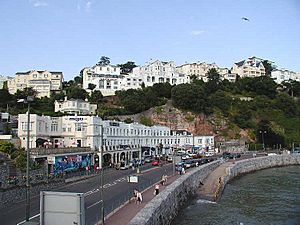
From 2014 to 2016, Devon's attractive lifestyle started bringing in new businesses. These businesses don't need to be in a specific place. For example, Dartmoor has seen a big increase in people working in digital and financial services. The Met Office, which is the UK's weather service, moved to Exeter in 2003. Plymouth is home to the main office and first store of The Range, a big national retail chain.
Tourism has been a huge part of Devon's economy since the 1800s, when railways made it easy to visit seaside resorts. While British seaside resorts faced challenges in the mid-1900s, Devon's tourism has seen a comeback. This is partly due to camping, sports like surfing and cycling, sailing, and historical sites. The Dartmoor and Exmoor national parks, the Jurassic Coast, and the Cornwall and West Devon Mining Landscape World Heritage Sites also help. In 2019, visitors spent almost £2.5 billion in the county.
Popular activities include eating at sea-view restaurants, walking the South West Coast Path, cycling on the Devon Coast to Coast Cycle Route and Tarka Trail, water sports, surfing, and sailing in places like Salcombe.
Incomes can vary a lot across Devon. Some areas, especially around Exeter and Plymouth, have incomes close to or above the national average. However, some places have lower incomes.
Getting Around Devon
Buses
Devon has a network of bus services. Some of the main bus companies are Stagecoach, AVMT Buses, County Bus, and Plymouth Citybus.
Trains
Great Western Railway is the main train company in Devon. They run many local services, as well as longer journeys to London Paddington and south to Plymouth and Penzance. Other companies like CrossCountry and South Western Railway also run services through Devon. All trains in Devon use diesel, as there are no electric train lines.
Okehampton station was closed to passengers in 1972. But in November 2021, regular passenger services to Exeter started again, thanks to a government program. There are also ideas to reopen other old train lines to improve travel in Devon.
Devon Metro
Devon County Council has a plan called 'Devon Metro' to make train services better. This plan aims to offer a good alternative to driving. It includes opening new stations, like Cranbrook station (opened in 2015) and Marsh Barton station (opened in 2023). The plan also includes more frequent local train services.
Air Travel
Exeter Airport is the only passenger airport in Devon. In 2019, over one million people used it. Until 2020, the airline Flybe had its main office there. You can fly from Exeter to various places in the UK and other countries like Cyprus, Italy, Spain, and France.
Devon's Landscape and Rocks
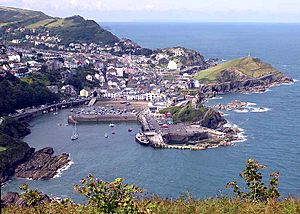
Devon is on a peninsula, so it has two coastlines. One is on the Bristol Channel in the north, and the other is on the English Channel in the south. The South West Coast Path runs along both coastlines. About 65% of this path is called a Heritage Coast, meaning it's a special natural area.
Devon is the fourth largest county in England by area. The island of Lundy and the Eddystone reef are also part of Devon. The county has more miles of roads than any other county in England.
Inland, the Dartmoor National Park is entirely within Devon. Part of the Exmoor National Park is also in Devon (the rest is in Somerset). Besides these wild moorlands, Devon has beautiful rolling countryside and villages with thatched cob cottages. All these features make Devon a very popular place for holidays.
In South Devon, you'll find rolling hills and small towns like Dartmouth, Ivybridge, and Totnes. Torquay and Paignton are the main seaside resorts on the south coast. East Devon has Exmouth, the first seaside resort in the county, and the more elegant Georgian town of Sidmouth. Exmouth is the western end of the Jurassic Coast World Heritage Site. A notable feature is the coastal railway line between Newton Abbot and the Exe Estuary, offering dramatic views of red sandstone cliffs.
North Devon is very rural with fewer large towns. The main ones are Barnstaple, Bideford, and Ilfracombe. Devon's Exmoor coast has the highest cliffs in southern Britain, including the Great Hangman, which is a 318 m (1,043 ft) hill with a 250 m (820 ft) cliff-face near Combe Martin Bay. The beaches in Bideford Bay (like Woolacombe and Croyde) are great for surfing because they face the Atlantic Ocean.
Devon's Geology (Rocks)
A geological line runs across Devon, roughly along the M5 motorway east of Tiverton and Exeter. This line divides Britain into a southeastern area with gently sloping sedimentary rocks and a northwestern area with igneous rocks and folded rocks.
The main types of rocks in Devon are:
- Devonian rocks: Found in north and southwest Devon. These rocks are about 395–345 million years old. Sandstones and shales formed under tropical seas. Limestones formed in shallower waters near Torquay and Plymouth. This geological period was named after Devon in the 1840s, making it the only British county to have a geological time period named after it!
- Culm Measures: These rocks are from the Carboniferous period and are found in northwest Devon. They are named after a soft, sooty coal called culm. This rock formation creates a gentler, greener landscape.
- Dartmoor granite: This large granite area is in central Devon and forms the "spine" of the southwestern peninsula.
Other rocks in eastern Devon include Permian and Triassic sandstones, which create the fertile red soils. There are also Jurassic rocks in the easternmost parts. You can find Cretaceous chalk cliffs at Beer Head and ball clay deposits in the Bovey Basin, which formed about 50 million years ago.
Devon's Weather
Devon generally has mild weather, thanks to the North Atlantic Drift. In winter, snow is rare unless you are on high ground. Summers are usually warm, with some very hot days and some cool, rainy periods. Winters are mild, with average daily maximum temperatures in January around 10 °C (50 °F).
Rainfall varies a lot. Dartmoor can get over 2,000 mm (79 in) of rain, while the southeast coast and Exeter get around 750 mm (30 in). Sunshine also varies; the moors are often cloudy, but the southeast coast is one of the sunniest parts of the UK. In summer, areas like Saunton and Croyde can be very hot when winds come from the east. Torbay and Teignmouth also get warm and sunny weather due to shelter from high ground.
| Climate data for Devon | |||||||||||||
|---|---|---|---|---|---|---|---|---|---|---|---|---|---|
| Month | Jan | Feb | Mar | Apr | May | Jun | Jul | Aug | Sep | Oct | Nov | Dec | Year |
| Mean daily maximum °C (°F) | 8 (46) |
8 (46) |
10 (50) |
12 (54) |
15 (59) |
18 (64) |
19 (66) |
19 (66) |
18 (64) |
15 (59) |
11 (52) |
9 (48) |
13.5 (56.3) |
| Mean daily minimum °C (°F) | 4 (39) |
4 (39) |
5 (41) |
6 (43) |
8 (46) |
11 (52) |
13 (55) |
13 (55) |
12 (54) |
9 (48) |
7 (45) |
5 (41) |
8 (46) |
Devon's Wildlife
Devon has many different types of natural areas, which means it has a wide variety of wildlife. Birdwatchers often try to spot over 100 different bird species in the county in one day! Wildlife is protected by groups like the Devon Wildlife Trust, which manages 40 nature reserves. The RSPB also has reserves here.
Devon's plants are very diverse, with some rare species found only here and in Cornwall. There are many reports and books about Devon's plants, with the latest being "A New Flora of Devon" published in 2016.
Because of rising temperatures, Devon has become the first place in modern Britain to grow olives for sale.
Cities, Towns, and Villages
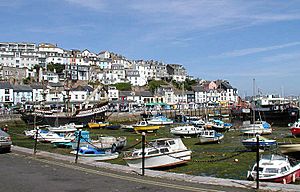
The main cities in Devon are Plymouth, a historic port, and Exeter, the county town. Torbay, which includes Torquay, Paignton, and Brixham, is the county's main tourist area. Many of Devon's coastal towns grew quickly in the 1800s when railways made them easy to reach. Examples include Dawlish, Exmouth, and Sidmouth on the south coast, and Ilfracombe and Lynmouth on the north.
Rural market towns in Devon include Barnstaple, Bideford, Honiton, Newton Abbot, Okehampton, Tavistock, Totnes, and Tiverton.
The border with Cornwall has changed over time. Until the late 1800s, some areas near Torpoint were part of Devon. Also, five parishes now in northeast Cornwall were part of Devon until 1974.
Religion in Devon
Old and Medieval Times
The earliest known religions in Devon were Celtic and Roman practices. Christianity arrived in Devon in the first centuries AD. In the Sub-Roman period, the church in Britain had some different practices from the rest of Europe, known as Celtic Christianity. However, it was always connected to the wider Roman Catholic Church. Many Cornish saints are remembered in Devon through legends, churches, and place names. Saint Petroc is said to have traveled through Devon, and many churches and places like Petrockstowe are named after him. The flag of Devon is also dedicated to Saint Petroc.
Over time, Devon became part of the kingdom of Wessex, and the church organization changed. In 1050, Bishop Leofric became the first Bishop of Exeter, making Exeter the main church city for Devon and Cornwall.
Later Religious History
In 1549, the Prayer Book Rebellion happened, which was a conflict over religious changes. During the English Reformation, churches in Devon officially became part of the Church of England. From the late 1500s, strong Protestant beliefs became popular in some parts of Devon, while other areas remained more traditional. These differences became clear during the English Civil War (1642–46), when the county was divided by religious beliefs.
Methodism, started by John Wesley, became very popular with working-class people in Devon in the 1800s. Methodist chapels were important social centers. Today, Methodism is still a big part of religious life in Devon, although fewer people are religious now compared to after World War II.
The Diocese of Exeter is still the Anglican (Church of England) diocese for all of Devon. The Roman Catholic Diocese of Plymouth was set up in the mid-1800s.
Jewish History
Even though Devon has a small Jewish population, it has two of Britain's oldest synagogues. These are in Plymouth and Exeter, built in 1762 and 1763.
Devon's Symbols
Coat of Arms
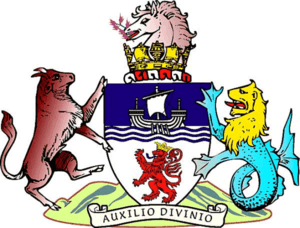
Devon did not have its own official coat of arms until 1926. Before that, the arms of the City of Exeter were often used to represent Devon.
On October 11, 1926, the county council received its own coat of arms. The main part of the shield shows a red crowned lion on a silver background. This comes from the arms of Richard of Cornwall. The top part of the shield shows an old ship on waves, representing Devon's strong seafaring history. The Latin motto chosen was Auxilio Divino, which means "by Divine aid." This was the motto of Sir Francis Drake.
Later, in 1962, more parts were added to the arms. The crest is the head of a Dartmoor Pony rising from a "Naval Crown." This special crown is made from ship parts and is linked to the Royal Navy. The supporters, which are figures holding up the shield, are a Devon bull and a sea lion.
Flag
Devon also has its own flag, dedicated to Saint Petroc, a local saint. The flag was chosen in 2003 after a competition run by BBC Radio Devon. The winning design was created by Ryan Sealey. The flag's colors are those often linked with Devon, like the colors of Exeter University and the local rugby union team. The flag was officially recognized by the county council in 2006.
Place Names and Traditions

Many place names in Devon end with "coombe" or "tor." "Coombe" means a valley or hollow, and "tor" refers to granite rock formations. These words come from old Celtic languages and are common in Devon, which borders Cornwall, where Celtic languages were spoken.
Devon has many festivals and old traditions. One is the Wassail in Whimple every January 17th, where people visit orchards. Another is the carrying of flaming tar barrels in Ottery St. Mary on Bonfire Night. People who have lived in Ottery for a long time run through the village with flaming barrels on their backs! Berry Pomeroy still celebrates Queene's Day for Elizabeth I.
Education in Devon
Devon mostly has a comprehensive education system, meaning schools are open to all students regardless of ability. There are 37 state secondary schools and 23 independent (private) secondary schools. The county also has three colleges for further education and an agricultural college (Bicton College).
Torbay has 8 state secondary schools, including 3 grammar schools. Plymouth has 17 state secondary schools, with 3 grammar schools (two for girls and one for boys). The largest school populations are in East Devon and Teignbridge.
Devon is home to two universities: the University of Exeter and the University of Plymouth. These universities have also teamed up to form the Peninsula College of Medicine and Dentistry. There is also Schumacher College.
Devon's Food
Devon is famous for some special foods. The Devonshire cream tea, with scones, jam, and clotted cream, is thought to have started here. In other countries, like Australia, it's even called a "Devonshire tea."
In October 2008, Devon was given "Fairtrade County" status by the Fairtrade Foundation. This means the county supports fair trade practices.
Sports in Devon
Devon has its own traditional sports, like Devon wrestling, which is similar to Cornish wrestling. In the 1800s, over 17,000 people watched a match between the champions of Devon and Cornwall. Another old Devon sport was outhurling, played until the 1900s. Other old customs include Dartmoor step dancing.
Devon has three professional football (soccer) teams. As of 2023, Plymouth Argyle F.C. plays in the EFL Championship, Exeter City F.C. in EFL League One, and Torquay United F.C. in the National League.
Rugby Union is also very popular in Devon, with over forty clubs. One club, Exeter Chiefs, plays in the top English league, the Aviva Premiership, and won the title in 2017. Plymouth Albion plays in the third tier of English professional rugby.
There are five rugby league teams in Devon, including Plymouth Titans and Exeter Centurions. They all play in the Rugby League Conference.
The Plymouth City Patriots represent Devon in the British Basketball League. Motorcycle speedway is also popular, with teams like the Exeter Falcons and Plymouth Gladiators.
The University of Exeter Hockey Club has teams in both the men's and women's national hockey leagues.
Horse racing is also popular, with two racecourses (Exeter and Newton Abbot). Devon also has many successful professional racehorse trainers.
In cricket, Devon is represented by Devon County Cricket Club, which plays at a Minor counties level.
Famous People from Devon
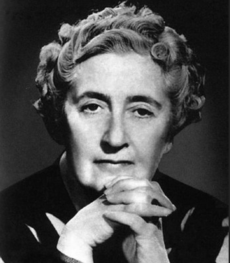
Devon is known for its famous sailors, such as Sir Francis Drake, Sir Walter Raleigh, and Sir Francis Chichester. Henry Every, a well-known pirate from the late 1600s, was likely born in Newton Ferrers. Robert Falcon Scott, who led an expedition to the South Pole, was also a Devonian.
Many famous writers have lived in Devon, including the poet Samuel Taylor Coleridge, crime writers Agatha Christie and Bertram Fletcher Robinson, and poet Ted Hughes. The painter Sir Joshua Reynolds, who founded the Royal Academy, was born in Devon. Chris Dawson, the billionaire owner of The Range stores, was born in Devon and his company's main office is still in Plymouth.
Actors like Matthew Goode and Bradley James were raised or born in Devon. Musicians from Devon include Joss Stone, Chris Martin (lead singer of Coldplay), and the members of the band Muse (Matt Bellamy, Dominic Howard, and Chris Wolstenholme). Dave Hill from the rock band Slade was born in Devon. Singer-songwriter Ben Howard grew up in Totnes. The model and actress Rosie Huntington-Whiteley was born in Plymouth and grew up in Tavistock. The singer Rebecca Newman was born and raised in Exmouth. Roger Deakins, a famous cinematographer, was born and lives in Devon.
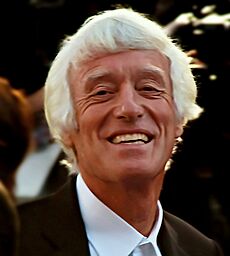
Trevor Francis, a professional footballer and the first English player to cost £1 million, was born and grew up in Plymouth.
Devon has also been represented in the House of Commons by important Members of Parliament (MPs) like Nancy Astor and Michael Foot. Two Prime Ministers, Lord John Russell and Lord Palmerston, also had connections to Devon.
See also
 In Spanish: Devon para niños
In Spanish: Devon para niños


